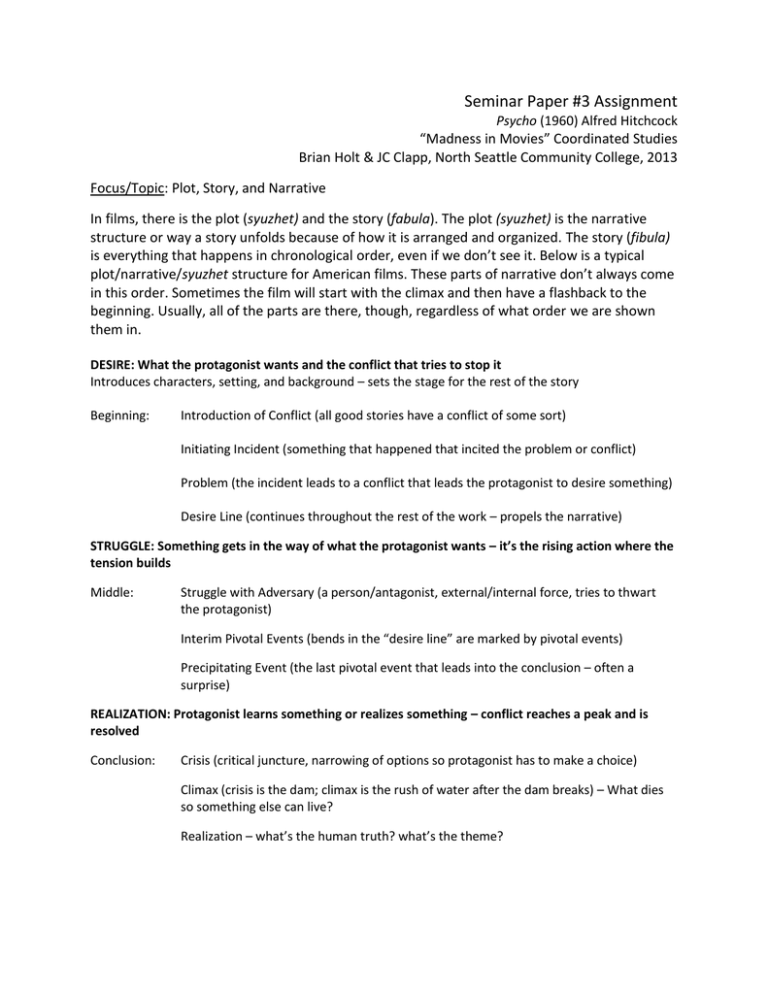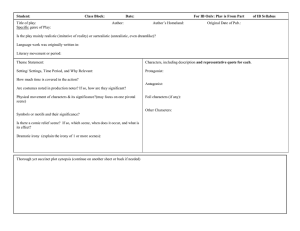Seminar Paper #3 Assignment
advertisement

Seminar Paper #3 Assignment Psycho (1960) Alfred Hitchcock “Madness in Movies” Coordinated Studies Brian Holt & JC Clapp, North Seattle Community College, 2013 Focus/Topic: Plot, Story, and Narrative In films, there is the plot (syuzhet) and the story (fabula). The plot (syuzhet) is the narrative structure or way a story unfolds because of how it is arranged and organized. The story (fibula) is everything that happens in chronological order, even if we don’t see it. Below is a typical plot/narrative/syuzhet structure for American films. These parts of narrative don’t always come in this order. Sometimes the film will start with the climax and then have a flashback to the beginning. Usually, all of the parts are there, though, regardless of what order we are shown them in. DESIRE: What the protagonist wants and the conflict that tries to stop it Introduces characters, setting, and background – sets the stage for the rest of the story Beginning: Introduction of Conflict (all good stories have a conflict of some sort) Initiating Incident (something that happened that incited the problem or conflict) Problem (the incident leads to a conflict that leads the protagonist to desire something) Desire Line (continues throughout the rest of the work – propels the narrative) STRUGGLE: Something gets in the way of what the protagonist wants – it’s the rising action where the tension builds Middle: Struggle with Adversary (a person/antagonist, external/internal force, tries to thwart the protagonist) Interim Pivotal Events (bends in the “desire line” are marked by pivotal events) Precipitating Event (the last pivotal event that leads into the conclusion – often a surprise) REALIZATION: Protagonist learns something or realizes something – conflict reaches a peak and is resolved Conclusion: Crisis (critical juncture, narrowing of options so protagonist has to make a choice) Climax (crisis is the dam; climax is the rush of water after the dam breaks) – What dies so something else can live? Realization – what’s the human truth? what’s the theme? Your Tasks (What your paper should include): Separate and label each section, please. Section 1: Outline/identify the narrative structure of Psycho (about 1 page outline) Section 2: Discuss and analyze the difference between the story and the plot in this film, using examples from the film to illustrate your points, as necessary. (about ½ a page) Grading Criteria for Sections 1 & 2 (10 points): Identification of the parts of narrative in the film Discussion of the difference between the story and the plot A minimum of 500 words (about 1 ½ pages) A heading that includes the name of the film, the year, and the name of the director Assignment typed in 12 pt. font, double spaced, and has 1 inch margins Grammatically correct and proofread Section 3: Consider what we’ve been learning about film editing and how it’s used to communicate. Choose one scene in Psycho (not the shower scene!) and describe and analyze the editing in that scene. Explain how the scene is edited and what those editing choices communicate to the audience (about 1 page). Be sure to give us the time stamp. Grading Criteria for Section 3 (5 points): Identification of one scene (not the shower scene) with a time stamp Discussion of what the editing in the scene communicates to the viewer A minimum of 300 words (about 1 page) Grammatically correct and proofread Section 4: Think about how Psycho portrays men and women. What messages does the film send about gender? Choose one scene and analyze how gender is constructed in that scene. What does that scene tell us about what it means to be a man? A woman? How might that portrayal of gender be connected to the historical time period the film was made in (1960)? Provide about 1 page of analysis. Grading Criteria for Section 4 (5 points): Identification of one scene with a time stamp Discussion of how gender is constructed in that scene – what messages about men/women are portrayed? Connection of discussion to the historical time period A minimum of 300 words (about 1 page) Grammatically correct and proofread What your paper should not include: a biography of the director or actors a synopsis of what the director/actors say in the “Director’s Cut” of the film the use of any research (everything in your paper should be your own analysis, not analysis you’ve read from research sources) -- if we find anything that is from any sources (even if you cite them correctly) you will not earn a passing grade

